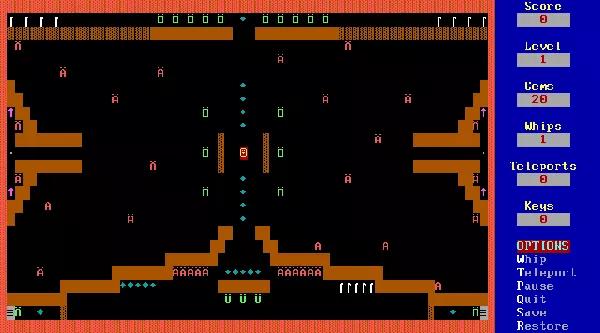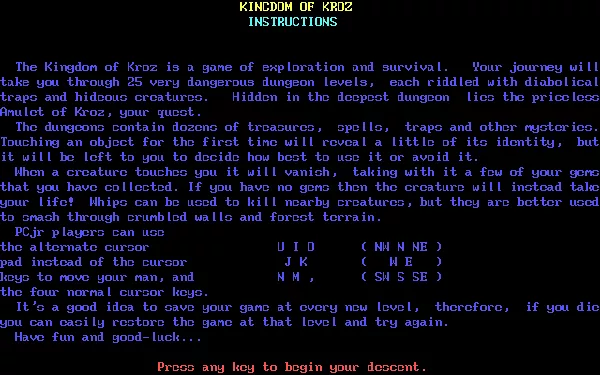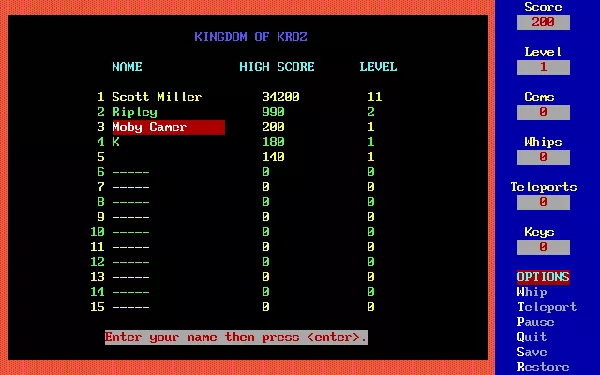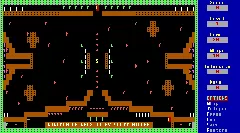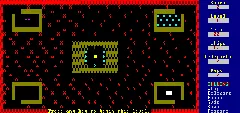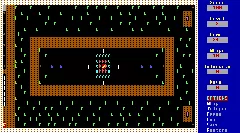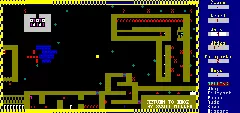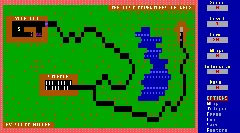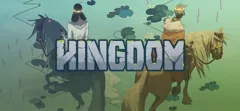Kingdom of Kroz
Description
A text-mode action/puzzle game. You have to get to the exit on each level, which is made more difficult by obstacles such as trees (which can be destroyed) and monsters. Various puzzles (in the form of one-off objects) are also used.
Groups +
Screenshots
Credits (DOS version)
| Creator |
Reviews
Players
Average score: 2.8 out of 5 (based on 4 ratings with 2 reviews)
Classic gameplay that is hard to match.
The Good
It is a game that makes you think but dosen't bill itself as a puzzle game (although I do enjoy puzzle games), but still makes you think about what you should do. From the seemingly lifeless standard set of DOS characters, Apogee has given life to the almost evil-looking head that smiles. The level design is some of the best I have ever seen and probaly ever will see. Also, the controls are very simple and easy to get used to making for an enjoyable game.
The Bad
To be honest the graphics push DOS characters to the limit, and that isn't saying very much. Sprites would have been a good addition to the game. As for sound, well there isn't much to say about it. PC Speaker just dosen't work on most games.
The Bottom Line
Play the Kingdom of Kroz and you will come out a happy person.
Be the first to rate this review!
Did you find this review helpful?
DOS · by Derrick 'Knight' Steele (2344) · 2000
It’s Gauntlet in ASCII form, with only one protagonist
The Good
I was a fan of Apogee Software way back in the ‘90s, having played most of their software catalog ranging from Wolfenstein 3-D and Raptor. I always believed that the company was launched in the early ‘90s; little did I know that it was actually established in the mid-’80s by Scott Miller. Miller kicked the company off and wrote two text adventures, namely Beyond the Titanic in 1986 and Supernova in 1987. After Supernova, he wanted to create something other than a text adventure, along the lines of Rogue. The result was Kingdom of Kroz, a game that won him second place in a national contest known as CodeQuest.
The game was quite popular that Miller creating six more games over the years, with the first three being Kingdom, Caverns of Kroz, and Dungeons of Kroz, and all of these three games were dubbed “The Kroz Trilogy”. For this review, I will be only focusing on the first game. You objective is to search 25 chambers for the rare Magical Amulet, and collect as many items as you can to help you achieve your goal. Each chamber is littered with monsters that need to be avoided or killed. There are also hazards you need to avoid, such as lava and endless pits. (I love what happens when you fall down one of these!)
One of the most useful items is the whip. Unlike other games where your weapon can only fire in one direction, the whip is swung in all eight directions, killing monsters that are surrounding you, as well as any terrain that is blocking your path. Other items that you can pick up along the way include gems (your health), teleports, keys, and power-ups that you need to utilize from time to time.
Of these other items, the keys are self-explanatory. The teleports, on the other hand, are useful for a quick getaway. Not only can they be used to get you from point A to B quicker (providing that you don’t end up in the wrong place), but their use is essential in some chambers, with an example being in the level “Big Trouble”, where you enter the chamber surrounded by water with no way out, while surrounded by up to 10 monsters.
When you touch an item for the first time, the game will tell you what it does. This also applies when you reload your saved game. Another feature that I like is the ability to pause the game, allowing you to find the safest way to leave the chamber without running into too many monsters or obstacles. This becomes particularly crucial in the even-numbered chambers, where you’re up against about a lot of monsters surrounding you. In these types of chambers, you also need to figure out how many times you can use the whip to kill monsters.
The graphics for the game are based on the IBM PC character set. The player is represented by a smiley face, the whips represented as canes, and teleports represented as up arrows. The monsters have different appearances and colors, which indicate their severity. The red monsters are less aggressive then the blue ones. All of the characters stand out if you are running the game with color graphics.
You can control the protagonist simply by using the standard four arrows. You can also utilize the numeric keypad, meaning if you are surrounded by hazards such as pits and lava, you can move diagonally to any empty space adjacent to your location.
The sound effects are only heard from the PC speaker, as sound cards weren’t available at the time. You hear a beep every time you move your protagonist. In my opinion, the most satisfying effect is heard when you run into a “Magic Bomb”, which destroys anything within a five-block radius.
The Bad
In a few levels, I found myself running out of items required to leave the chamber because I used them up in the levels beforehand. In one of the later levels, for example, there are so many locked doors that you need to open. It would have been useful if the required items were already supplied in each chamber so that you don’t have to start the game again in case you don’t have enough.
The Bottom Line
Kingdom of Kroz was released around the early days of Apogee Software, whose games were created by one man. It is a game where the graphics are represented in ASCII form. The object is to navigate 25 chambers in search of the Magical Amulet. The chambers are dangerous because there are certain types of monsters that you need to avoid, as well as other hazards like lava and endless pits.
Also containing elements of puzzle-solving, you also need to work out the best way to get through each chamber without coming into contact with monsters or hazards. So in conclusion, Kingdom - as well as the other games in “The Kroz Trilogy” proves that even if you do something in ASCII, you can still make great games.
The game was released as freeware on the 3D Realms web site, along with its source code. The game is made in TP3.0, and if you understand it, you will be able to modify it to your heart’s content without running into errors or other problems. I already used it to give me 10,000 of each item so I wouldn’t run out like I did when I played it properly.
Be the first to rate this review!
Did you find this review helpful?
DOS · by Katakis | カタキス (43085) · 2019
Trivia
Covermount release
This game was included in issue 20 (June, 1988) of Softdisk Publishing's Big Blue Disk magazine.
References
The name "Kroz" didn't come out of a hat - it was Zork spelled backwards, probably as an ode to Infocom's game
Release
Scott Miller didn't create the try-before-you-buy concept of shareware, but he was the first one to make it profitable. In 1987, Miller realized that selling an entire game online would not make money, so he put his marketing education into action and split his 75-level Kroz game into three episodes, releasing the first episode, Kingdom of Kroz, as shareware. It served as a self-perpetuating advertisement for the remaining two episodes. He was soon bringing in more income from his game sales than from his day job - as much as $500 a day and $2000 per week.
Source code
You could buy the source code of this game for $190. It's programmed in Turbo Pascal 3.0.
Information also contributed by Demian Katz, Frenkel and Maw
Analytics
Related Sites +
- Apogee FAQ
The official Apogee FAQ, which lists information on all the Kroz games.
Identifiers +
Contribute
Are you familiar with this game? Help document and preserve this entry in video game history! If your contribution is approved, you will earn points and be credited as a contributor.
Contributors to this Entry
Game added by Retron.
Additional contributors: Trixter, Olivier Masse, Patrick Bregger.
Game added January 12, 2000. Last modified September 2, 2023.


